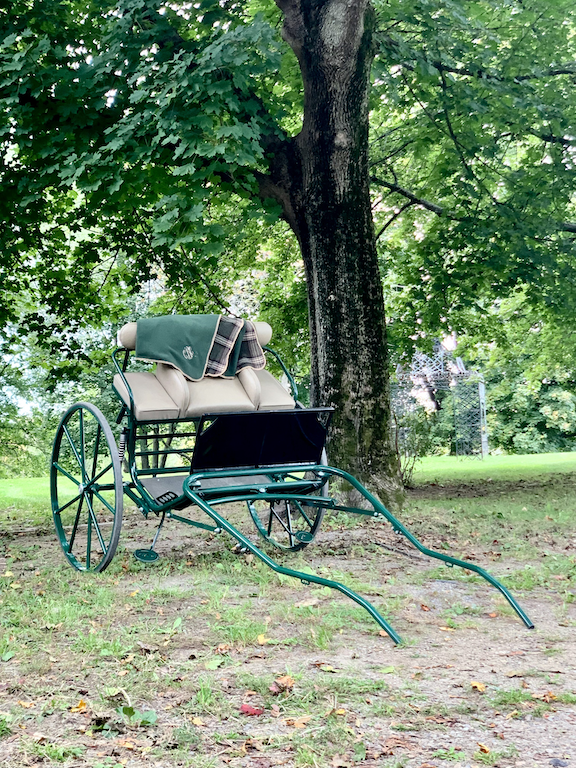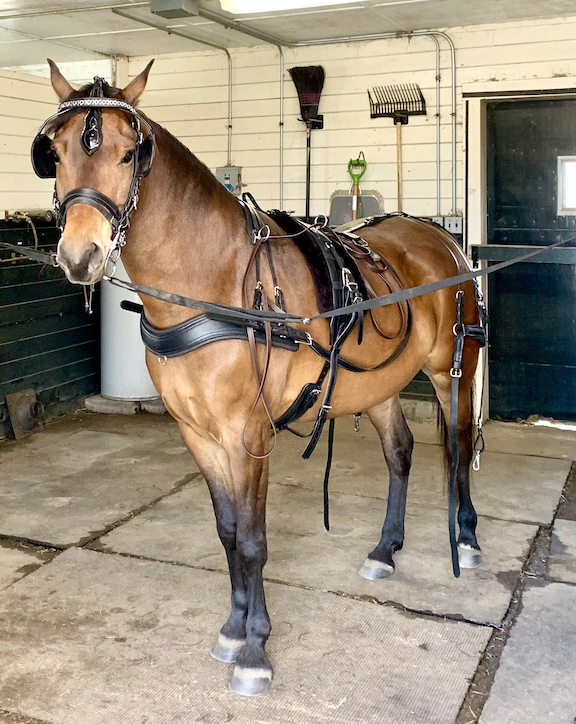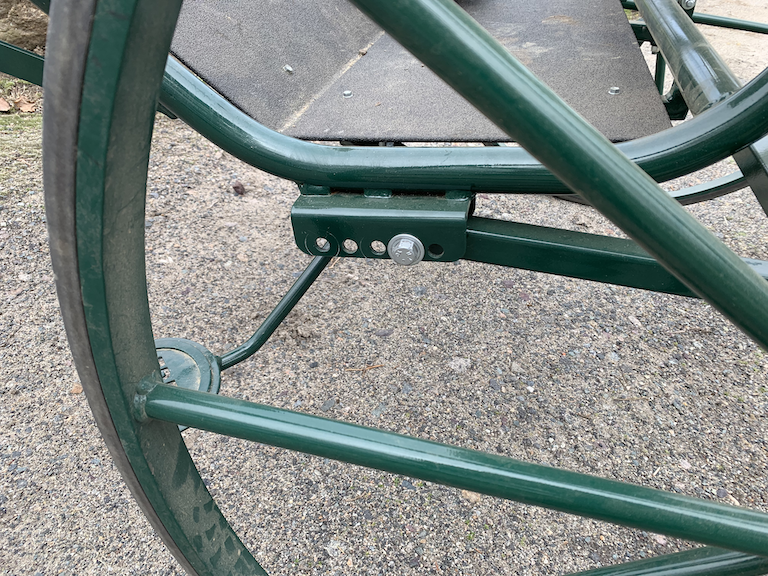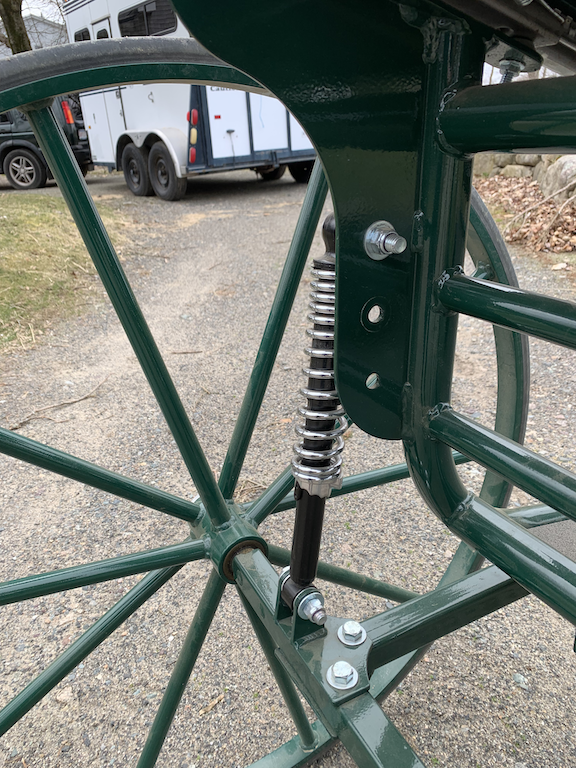Balancing the Frey Sprint Cart

Today, April 20th, is Levi's fifth birthday, so I'll be making a second birthday post after today's drive. We're currently waiting out a steady rain, and I'd like the footing to be a bit drier out but it is what it is, so I'm taking this sliver of time to write my promised post on balancing Levi's cart. For some background, you can read all about how and why we chose this style and manufacturer of the cart in our prior blog posts about it on Facebook (here https://www.facebook.com/photo/?fbid=475096721287419&set=a.349189413878151 and here https://www.facebook.com/photo/?fbid=430574532406305&set=a.349189413878151); the long and short of it is that back in 2022-2023, I had a custom cart designed and built specifically for Levi by the Frey Carriage Company, with the intention of using it for everything from training to pleasure showing to trails, driven dressage, obstacles, and cones. Maybe my original plan was to drive it to the moon - I don't remember exactly, but there were some high hopes. Since that time, many events have transpired with regard to the company, and I won't go into that here for brevity's sake and as it's not really germane. There exists a Facebook group related to the Frey Co. and products as well, which is very helpful for those interested. This particular post is intended to offer some assistance and guidance for those who own the Sprint carts (specifically the horse or cob sized carts only, as I can't offer any advice regarding the smaller pony carts) and who are struggling a little bit with fitting them, as we did. When it comes to adjusting, balancing, and changing settings on the carts, there is very little advice online, and there was little guidance from the company, and no manual available to my knowledge that would really assist drivers in making the most out of these otherwise outstanding carts. As a result, I am attempting to provide here as a public service our trials and tribulations with the hope of helping drivers.
Before I share how we struggled with, and ultimately overcame, our balancing issues, I want to convey just how much I actually love this cart, and am really happy that I did ultimately choose this to be our first one. I loved it at first sight, and you can see why - it is absolutely gorgeous and elegant in every way! I loved how easy it was, at first, to order and customize the cart, and interact with the company regarding my choices. I loved the breadth of options available for including just about any custom feature from bench style to paint colors; the online galleries of finished vehicles are a spectacular resource showcasing drivers' creativity in design. I really love the elegant but utilitarian style of the cart: I needed a front-entry, wedge seat design, solid metal with enough weight and heft to stand up to the rigors of training a green horse and working outdoors, yet lightweight enough that with the addition of a driver plus passenger the cart is still easy for the horse to pull relative to a heavier Meadowbrook, for example. I love that this cart is virtually silent; in fact, the only sound that I hear when I am driving is due to Levi's traces, which have a metal ring attachment intended for marathon driving, that knock against the metal shafts. I love how adjustable and comfortable the cart is as well. I tested the limits of this system and actually wound up taking this cart apart and putting it back together again, no worse for wear; I am posting this so that hopefully no one else has to go through that! Finally, if you saw the video in my last post of us driving through a spook, you might have noted just how stable the wedge seat kept my body position during the turns at a canter- this cart was definitely built to stand up to the sharp turns in obstacles during combined driving, and it is actually extremely comfortable and stable at a canter. Basically, there's a lot to love about these carts that make it really worthwhile to try to overcome some of the challenges they also present. It's a shame that people give up on them and sell them because they don't fit properly or just can't seem to balance correctly.

When the cart arrived in a shipping crate, it was in multiple pieces that needed to be assembled with a socket and ratchet set. The shafts are removable and fully adjustable, which is a feature I like as it will help with transporting to shows; however, the cart can fit in the bed of a large pickup truck with or without removing the shafts. The bench seat is completely removable, as are the wedge seat and seat pads with the exception of the far left pad which is attached. I can shift my wedge seat over to the right to accommodate a passenger. The bench seat has an adjustment lever beneath the seat that can be used to shift the seat forward and back, which is intended to help support the comfort of the driver, and it is not intended to be a determinant in balancing the cart.
After assembling the cart, I first attempted to find its balance point both with and without a passenger, in the standard approach, by lifting the ends of the shafts until the shafts and floor of the cart are level and the weight in the ends is negligible. Ideally, the height from the ground for the shafts at a featherweight point should also be where they would lie within the tug loops of the saddle. The first issue we encountered was that even if I lifted the shafts as high as my shoulders, there was still what felt like a non-negligible amount of weight in the ends of the shafts, and the shafts/floor were no longer level. I first attempted to alter the balance by shifting the bench backward with its lever, which did not seem to help at all. There was also a dispute regarding what 'negligible' weight really meant in this case, and how that weight would be distributed when the horse is hitched and in draft. As I strive to be very precise and careful about how and where there are points of stress on the horse, I was also concerned about this cart introducing too much weight over a small part of the horse's back. Unlike a riding saddle, a harness saddle has much less surface area over which to distribute weight, and although our saddle is treed which rescues the spine from directly bearing that weight, the goal is to put as little weight as possible on the back of the driving horse for his comfort and longevity. If you really want to rile people up, ask them to actually determine, by direct measurement, exactly how much weight is on the backs of their horses and ponies when hitched to a balanced cart with a driver sitting in it. From there, just start asking questions. You will either find yourself quickly without friends who vanish as a result of your challenge of the status quo and resulting inquiry, or you will attract a phalanx of cautious, determined nerds who also want to get to the bottom of this from a welfare and problem-solving standpoint. Welcome, Overthinkers, to our nerdery.
In any case, this situation presented an opportunity to not only learn but also correct some misconceptions regarding cart balance, and in particular, balancing the Sprint carts. I will save everyone from having to read another tome by getting to the end first: we were rescued purely by serendipity, as I was contacted on Facebook messenger by the person who actually designed and built our specific cart. Over several weeks they provided generous and thorough education and guidance in how exactly to balance this cart. I will be forever grateful for this unexpected help, which came not a moment too soon. I'll share all of that knowledge with you below, to your benefit.
First, let's clear up some misconceptions about balancing these carts. One that we hear commonly is that 'there should be no weight in the shafts', or 'there should be no weight on the back' which is false for a couple of reasons. I precisely measured that, when the shafts are at the height of the tug loops when the horse is hitched, without a passenger, our cart applies 10-12 lbs. of weight on each shaft, or 20-24 lbs total. When I sit in the cart with the seat all the way back and the adjustment points in the neutral (standard) position, that weight drops to about 7-9 lbs on each shaft. Once we actually balanced the cart using the adjustments I discuss in paragraphs below, this dropped to about 5 lbs. on each shaft, which is at the higher end of weight range I've heard is acceptable for a properly balanced cart. To facilitate proper balance at a trot, with this particular style of cart and shape of the shafts, we were also advised that having a bit more weight, e.g. up to 10 lbs., is actually acceptable in order to stabilize the shafts in the tugs and prevent bouncing. Regarding weight on the back, consider that a dressage saddle weighs about 20 lbs., and that a horse of Levi's age, weight, and height would have absolutely no problem bearing this relatively small amount of weight, with little to no danger of causing pain or injury to his back or spine. Bouncing is bad for many reasons, and trying to minimize it through wrapping the overgirth or shafts just passes the buck on to the horse, who still has to contend with the cart's imbalance and resulting movement even though the driver feels less of it. This can lead to sourness in the horse toward driving, as the shafts jolt up and down in the tugs or pull upward on his girth as he moves into a trot, and could be a cause of training problems that are purely avoidable. As it pertains to this style of cart which appears to be somewhere between a breaking cart, a road cart, and a gig, the ends of the shafts are curved, which confers more weight on the tugs and the shaft tips are not intended to 'float' like straight shafts, but instead to account for the higher level of action of the cart in motion. The weight introduced by the curved shafts, like those found on gigs, is accounted for through use of a traditional gig harness intended specifically for these heavier vehicles which includes a much wider saddle with a sliding backband and French tug loops to distribute weight across a greater surface area, and the use of a full collar instead of a breast collar to account for the lower line of draft. In this case, while the ends of shafts are curved somewhat, the line of draft on the Sprint cart is the same as other road style carts, where the point of attachment for the traces at the singletree is aligned with the shafts. The belly of the shafts is also straight, giving us a balance objective, and the ends are not a true curve but angled with a flat part to accommodate traditional open tug loops. As a result, we were advised to adjust the shafts accordingly:
- Before tightening the bolts that hold the ends of the shafts in place, turn the shafts such that the flat part where the tug loops lie is facing the horse. In the banner photo, the shafts are shown before this was done. In the driving videos in this post and the last post, we have made this minor adjustment to the shafts.
- Make sure that the ends don't 'hook out', and that the shafts are at a comfortable width to accommodate the horse. They should not brush or interfere with the shoulder in a turn (too narrow). You shouldn't see a large gap where the tugs are pulled outward by the shafts (too wide), and the tugs should not move forward or backward very much in draft.
- For my purposes, I also added the thickest saddle pad I could find to help distribute the weight a bit better. I tend to overly worry about these things, as I mentioned, because Levi is rather important to me and I don't want him injured from what amounts to intellectual differences of degree. I always carefully monitor Levi for any signs of soreness after every drive; to date, I have seen no indicators that he has any problems.
Based on the advice we received, we were also able to balance the cart using the built-in adjustment sites for this purpose. There are two major points for adjustment on the cart that will facilitate balancing. These are shown in the photos below, with descriptions on how to adjust for proper balance.

If the cart visibly bounces up and down like a lowrider car at a trot and it is clear the shafts are moving in the tugs, the cart is not balanced. Here is another misconception that we need to correct: bouncing of carts is acceptable because that is just how carts attached to some horses move. The cart should be lifted and lowered along with the shoulder movement in a trot, but not more than that. Some horses with higher action at a trot will lift the cart more than others. In any case, the shafts should stay level in the tugs. In the video of Levi and I driving, we can see his shoulder movement lifting the cart at a slow trot.
Finally, the driver's height, leg length and position can be accommodated for comfort by changing the bolt position above the springs, as in the image below. Lowering the bench helped me feel more comfortable, and less like I was perched high above the horse while driving.

I will gladly answer any questions about the cart, so if you want to know what exactly we did and how we did it, please subscribe and ask away. I will write Levi's birthday post tomorrow; we had a great drive today, and ten people attended his party at the farm. I know he feels very loved and seen tonight, as I do. Drive on, Levi! Welcome to year five of your life.
Member discussion